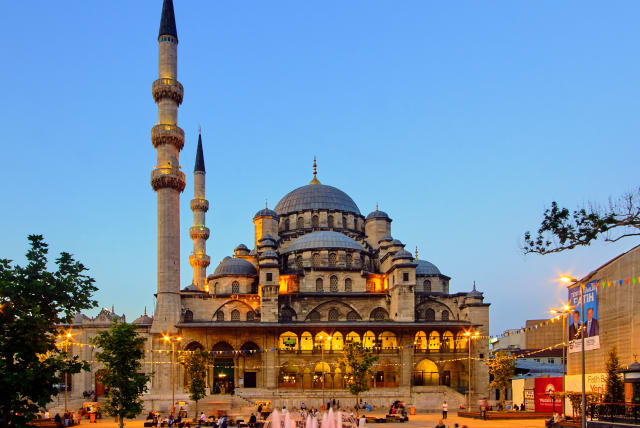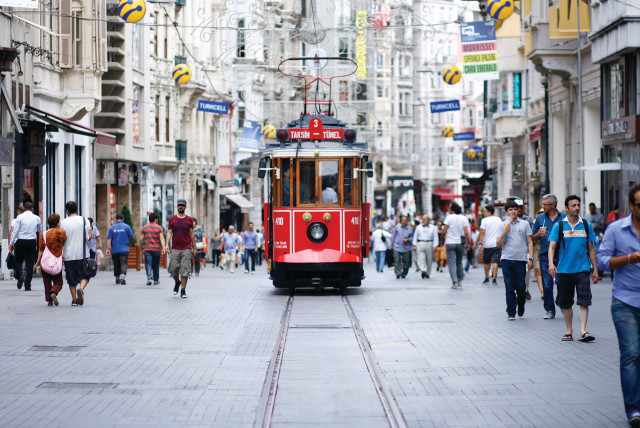Music, and more, to Istanbul’s ears and heart

The Istanbul Music Festival took place over four days and included Haydn, Schoenberg, Gershwin, Piazzolla, Albeniz, jazz, and Turkish classical music along with other international artists.
Istanbul is big. Strike that, it is immense, no, colossal. Any way you look at the sprawling Turkish megacity with a population estimated at around the 20 million mark, you get a sense of the scale of enormity, particularly when you are trying to navigate your way from A to B through traffic which, when it is not stock-still, seems to flow every which way.
But it is not only the sheer physical size of the metropolis, which straddles two continents, that palpably impresses the visitor. That geographic interface and Turkey’s imperial Ottoman past inform the culture of Istanbul on so many levels and, particularly, in the music created and embraced there.
The multifarious mindset resonated in the 51st edition of the Istanbul Music Festival that ran through the first half of June under the aegis of the Istanbul Culture and Arts Foundation. I caught several concerts over the space of four days which spanned the gamut of Haydn, Schoenberg, Gershwin, Piazzolla, Albeniz, jazz, and Turkish classical music.
That all made perfect sense in a city, and for a nation, that appears to accommodate seemingly disparate sounds and dynamics as a matter of course. And judging by the buskers that can be found accompanying their own singing on oud, baglama, or violin on street corners and on the boats that ferry people across the Bosphorus between the European and Asian sides of the city, the Turks have the requisite genes to put all of that into quality mellifluous form.
Living in a quintessential cultural melting pot, over at this end of the Middle East, that has absorbed and fused the sounds, scents, and seasonings of immigrants from so many places around the globe melded with local Arabic sensibilities, as an Israeli it is easy to slip into Turkish mode. And, on my several trips to Istanbul to date, contrary to some media-fueled opinion about a dark cloud of animosity and mistrust hanging between us, whenever I was asked whence I hail I was greeted with warmth and cries along the lines of “You are our brother!”
Art and culture in Istanbul
There are numerous layers to the Istanbul onion. There is a moderating, Europeanesque wind that blows through this vast leviathan of a city. That is clearly the message that underscores the recently lavishly refurbished Ataturk Cultural Center complex, which reopened for business in late 2021 with a gala ceremony attended by President Tayyip Erdogan and a whole host of local political and other A-listers.
The center’s new lease of artistic life kicked off, understandably, with a sumptuous production of a Turkish opera. But the festival fare we encountered there expressed an outward-looking, multipronged ethos which, presumably, is also tailored to appeal to culture consumers of different stripes, from across Turkey and the world. And so it should. Festival director Efruz Carkikaya deftly tugged on a multitude of genre and stylistic strings in compiling the expansive program.
Our festival portion opener featured the Borusan Istanbul Philharmonic Orchestra with irrepressible Canadian soprano-conductor Barbara Hannigan on the podium. We couldn’t have hoped for a more entertaining evening of Western classical music. The repertoire traversed broad tracts of creative intent, opening with American modernist composer Charles Ives’s stirring “Unanswered Question” It is an evocative-sounding work that prompts all sorts of thoughts and feelings, enhanced by the offstage positioning of the trumpeter in an intermittent call-and-response seesaw dialogue.
That segued seamlessly into Schoenberg’s velvety “Verklaerte Nacht.” Haydn’s “Symphony No. 96” got an oversweet reading for my palate, but Hannigan brought the concert home to a raucous, jaw-dropping, and fun crescendo as she reprised an enduringly popular rendition of Gershwin’s “Girl Crazy Suite.” We got to see what the 51-year-old singer’s vocals are up to as she peeled off the kid gloves, turned to face us, and reeled off the lyrics in as effervescent a style as one might hope to see in a full orchestra setting. Naturally, that meant turning her back on the ensemble but the instrumentalists needed little direction for the exercise. They even added some – scheduled – vocal interjections of their own.
There was the odd Jewish element to the trip. On the second day, following a traditional Turkish breakfast – actually, it was more along the lines of a brunch – we arrived at Ayios Dimitrios, a typically ornate Greek Orthodox church, dating back to the mid-15th century. The concert in the Balat neighborhood – once home to a sizeable Jewish community, with 18 synagogues – formed part of the Music Route@Balat section of the festival.
YOUNG ITALIAN DUO, guitarist Gian Marco Ciampa and cellist Erica Piccotti, took us through a Latin-Spanish roster with works by nuevo tango pioneer Astor Piazzolla as well as Albeniz, Granados, and de Falla. The two 20-somethings have clearly managed to chalk up some mileage together and the simpatico factor, along with silky musicianship, was evident from the off. The setting and the delivery made for a rewarding matinee experience.
It seemed unnatural to attend the Istanbul Music Festival and not catch some local sounds. That objective was achieved with gusto with The Sound in the Courtyard concert, at the picturesque recently restored Mevlanakapı Land Walls Visitor Center by the centuries-old walls of the Old City.
Unseasonably inclement weather notwithstanding – we were provided with throwaway plastic macs at the gate – it was a delight to see oud player extraordinaire Yurdal Tokcan spin out his magic in an all-Turkish quartet that included kamancheh player Neva Özgen, qanun player Safinaz Rizeli, and cellist Yelda Özgen garnishing the sonics with echoes of western classical textures. Tokcan has graced the Oud Festival in Jerusalem on several occasions and will be back here for this year’s edition in November.
There were several Israeli musicians on the festival roster, including Germany-based jazz pianist Omer Klein, who teamed up with German percussionist Alexej Gerassimez for a sterling performance of original works inspired by Stravinsky’s The Firebird. The outdoor virtuosic set, at the Four Seasons Bosphorus Atik Pasha Terrace, dipped into mainstream jazz, Spanish-leaning vignettes, Middle Eastern filigrees, and some suitably fiery climes.
Music apart, we hit several of the showcase tourist sites, including a de rigueur outing to the Historical Peninsula with the magnificent 1,500-year-old Hagia Sophia Grand Mosque, built as a Greek Orthodox church in 537 CE, and the equally imposing neighboring six-minaret Sultanahmet Mosque, aka Blue Mosque. We passed through the site of the 3rd-century CE hippodrome which, we were informed by our guide Elif, a veritable inexhaustible font of knowledge, accommodated 100,000 spectators back in the day. There was also a jaunt to the impressive atmospheric Basilica Cistern, with its tastefully illuminated archeological fittings and finds and contemporary works.
Symbolism is, apparently, a major feature of the Turkish ethos. Spying an enormous national flag fluttering from a towering mast on the European side of the city as we plowed our way across the Bosphorus to the trendy Kadiköy district, Elif explained that the flag measures exactly 1,453 sq. cm.
“That is a reference to the Ottoman conquest of Turkey in the year 1453,” she noted. Stands to historic reason.
One of the standout slots in the four-day agenda was an all-too-brief visit to Istanbul Modern. The spanking new contemporary art museum building, on the European waterfront in Karaköy, where the Bosphorus meets the Golden Horn, makes for impressive viewing, even with rain bucketing down and battleship-heavy grey clouds merging with the structure façade.
If any architect or museum planning team out there is looking to create a home for exciting, striking, thought-provoking, and alluring art they would do well to get themselves over to Istanbul Modern. Here is an art repository that simply and unpretentiously does its job and manages to present works that trace the evolution of Turkish art, post-1945, without imposing itself on the creative fruits.
Arresting abstract works by the likes of Nejad Melig Devrim and Fahreinissa Zeid, from the 1940s and 1950s, led smoothly on to the mesmerizing Retrospective II, from 1997, by Adnan Çoker, and the powerfully evocative 1973 Coffeehouse figurative effort by Bedri Rahmi Eyüboglu and Earth Man made by Neset Günal in 1974.
ON THE BRINK of stimulus-OD, I also squeezed in a circuit of the captivating photography offering by Turkish filmmaker Nuri Bilge Ceylan which closes in December. The 22-piece exhibition presents portrait-centric shots taken in Turkey and around the world. The subjects appear in a wide variety of urban and natural settings, all exuding patently understated emotional expressions. It makes for a compelling statement on the human condition.
Somewhat off the beaten touristy track, the Sabancı University Sakıp Sabancı Museum is a gem to behold. Located in Emirgan, one of the oldest areas on the banks of the Bosphorus, the museum is housed in a delectable villa built in 1925, designed by the Italian architect Edoardo De Nari and used as a summer residence by the family of Egyptian Prince Mehmed Ali Hasan.
The building houses an eclectic display of calligraphy and ancient manuscripts, as well as opulent period interior furnishings, and evocative portraits by late 19th and early 20th-century Turkish painter Osman Hamdi Bey. The museum also offers a rota of temporary exhibitions. Currently, the lower level of the building is occupied by the spread called Turkish Painting: In the Pursuit of Modernism, which feeds off the period of modernization between the late Ottoman Empire and the early Turkish Republic.
The lush grounds around the villa are no less inviting, offering gorgeous views of the Bosphorus and the waterway-hugging surroundings. There are also eye-catching contemporary works of art dotted around the place. In particular, the 9-meter-high Living Pyramid by now 92-year-old Hungarian-American conceptual artist Agnes Denes struck an enticing ecological and aesthetic note.
Out and about on the urban beat, the pulsating Istiklal Street pedestrian thoroughfare, a stone’s throw from our berth at the Marmara Pera Hotel, where locals and tourists alike stroll and prowl around the clock, was a constant murmuring backdrop during our stay. Supporters of the 2022-23 soccer champions Galatasaray also made good and thunderously boisterous use of the street on our last evening in Istanbul.
If there was a downside to the trip it was the relatively limited comestible options available to vegans. Over here we have become accustomed to filling our faces without too much bother. Istanbul has made progress in that regard in recent years but still has some ground to make up.
That said, the Muutto eatery we dropped into, on the swanky and tastefully reimagined Galata waterfront, did the tasty and aesthetic business and then some. And, oenophiles will have a ball in Turkey. Our own wine industry has come on in leaps and bounds over the past couple of decades, but nothing I supped in Istanbul was anything less than excellent.
And all just a two-hour flight away.
Jerusalem Post Store
`; document.getElementById("linkPremium").innerHTML = cont; var divWithLink = document.getElementById("premium-link"); if (divWithLink !== null && divWithLink !== 'undefined') { divWithLink.style.border = "solid 1px #cb0f3e"; divWithLink.style.textAlign = "center"; divWithLink.style.marginBottom = "15px"; divWithLink.style.marginTop = "15px"; divWithLink.style.width = "100%"; divWithLink.style.backgroundColor = "#122952"; divWithLink.style.color = "#ffffff"; divWithLink.style.lineHeight = "1.5"; } } (function (v, i) { });

